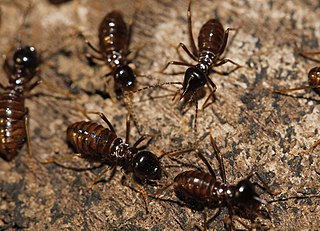Hypotermes makhamensis is a species of termite in the subfamily Macrotermitinae of the family Termitidae. It lives in dry evergreen forests in tropical south-eastern Asia and builds termite mounds in which it cultivates fungus for use as food.
Postelectrotermes militaris, the up-country tea termite, is a species of drywood termite of the genus Postelectrotermes. It is native to India and Sri Lanka. It is a serious pest of tea.
Neotermes greeni, is a species of drywood termite of the genus Neotermes. It is native to India and Sri Lanka. It closely resembles Postelectrotermes militaris. It is a minor pest of tea in Sri Lanka, and major pest of mango in India.
Kalotermes jepsoni, is a species of damp wood termite of the genus Kalotermes. It is native to India and Sri Lanka. It usually prefers to live in dead and decaying wood, but sometimes can be seen in live wood. It is a major pest of tea in Sri Lanka.
Glyptotermes ceylonicus, is a species of damp wood termite of the genus Glyptotermes. It is endemic to high elevations Sri Lanka. It is a pest of dead and decaying wood of Hevea, Theobroma, Ficus, and Acacia species.
The Low-country tea termite,, also known as Low country live wood termite, is a species of damp wood termite of the genus Glyptotermes. It is endemic to high elevations Sri Lanka. It is a major pest of tea in low country area of Sri Lanka.
Cryptotermes ceylonicus, is a species of dry wood termite of the genus Cryptotermes. It is found in Sri Lanka. It is found in living wood, and other man-made wooden constructions. They possess teeth-less mandibles.
Cryptotermes perforans is a species of dry wood termite of the genus Cryptotermes. It is endemic to Sri Lanka. It is found in dead wood of Syzygium cumini, attack on other dressed timber and wooden furniture.
Coptotermes emersoni, is a species of subterranean termite of the genus Coptotermes. It is native to India, Sri Lanka, and Vietnam. Though it is a wood destroying termite, it was first found from an electrical wire case in the National Museum of Colombo.
Coptotermes gaurii, is a species of subterranean termite of the genus Coptotermes. It is native to South India and Sri Lanka. It is a serious pest of tea in Sri Lanka.
Heterotermes ceylonicus is a species of subterranean termite of the family Rhinotermitidae. It is native to India and Sri Lanka. It is a wood destroying termites, which damage to logs, wooden structures of both natural and man-made such as tree stumps of Gravellia and Hevea brasiliensis, and tea plantations. It can be also found in mounds of Hypotermes obscuriceps.
Odontotermes ceylonicus, is a species of termite of the genus Odontotermes. It is native to India and Sri Lanka. Though nests in the ground, they never construct termitaria. It attacks many dead, diseased rotten plant roots and wooden buildings. It is a major pest of sugarcane and a secondary pest of tea.

Odontotermes horni, is a species of termite of the genus Odontotermes. It is native to India and Sri Lanka. It attacks many dead, decaying trees and fertilized soil. Though nests on ground, they do not construct a termitaria. It is a pest of tea, coconut and sugarcane.
Odontotermes koenigi, is a species of termite of the genus Odontotermes. It is native to India and Sri Lanka. It is a pest of tea.
Odontotermes redemanni, is a species of termite of the genus Odontotermes. It is native to India and Sri Lanka. It damages wooden constructions. It is a pest of sugarcane, tea and coconut. They construct termitaria during November to March when rainfall and ambient temperature become low. Underground termite nests of this species are a natural host for the important Traditional Chinese Medicine fungus Xylaria nigripes, also known as Wu Ling Shen.
Hypotermes winifredi, is a species of termite of the genus Hypotermes. It is native to India and Sri Lanka.
Nasutitermes ceylonicus, is a species of termite of the genus Nasutitermes. It is found in Sri Lanka. It is a pest of tea and coconut. It damages numerous wooden constructions, and timber in buildings.

Hospitalitermes monoceros, is a species of nasute termite of the genus Hospitalitermes. It was originally considered to be endemic to Sri Lanka, but was also found in India in 2013. It is an obligate lichen feeder. It is recorded from Cassia multijuga and Ficus religiosa trees and is a pest of tea.
Microcerotermes greeni, is a species of small termite of the genus Microcerotermes. It is found from Ambalangoda area of Sri Lanka. It is a secondary pest of tea.

